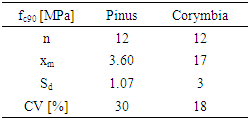-
Paper Information
- Previous Paper
- Paper Submission
-
Journal Information
- About This Journal
- Editorial Board
- Current Issue
- Archive
- Author Guidelines
- Contact Us
Journal of Civil Engineering Research
p-ISSN: 2163-2316 e-ISSN: 2163-2340
2017; 7(3): 105-107
doi:10.5923/j.jce.20170703.03

Compression Strength of Brazilian Exotics Wood Species Perpendicular to the Grain
Diego Henrique de Almeida1, Tiago Hendrigo de Almeida2, Fabiane Salles Ferro3, André Luís Christoforo4, Francisco Antonio Rocco Lahr5
1Department of Civil Engineering (DECIv), Federal University of São Carlos (UFSCar), São Carlos, Brazil
2Department of Materials Engineering (SMM), Engineering School of São Carlos (EESC), São Paulo University (USP), São Carlos, Brazil
3Department of Forestry, State University of Paraná (UNICENTRO), Irati, Brazil
4Faculty of Engineering and Architecture, FUMEC University, Belo Horizonte, Brazil
5Department of Structures Engineering (SET), Engineering School of São Carlos (EESC), São Paulo University (USP), São Carlos, Brazil
Correspondence to: Diego Henrique de Almeida, Department of Civil Engineering (DECIv), Federal University of São Carlos (UFSCar), São Carlos, Brazil.
| Email: |  |
Copyright © 2017 Scientific & Academic Publishing. All Rights Reserved.
This work is licensed under the Creative Commons Attribution International License (CC BY).
http://creativecommons.org/licenses/by/4.0/

Wood is a natural material that present variability of their properties. When used as ties in railways or as bridges decks, wood is request with compressive loads in direction perpendicular to the grain. The aim of this research is determining the compressive perpendicular to the grain strength (fc90) of two Brazilian exotic wood species. Tests were carried out using wood of Corymbia (Corymbia citriodora) and Pinus (Pinus taeda L.). Specimens and test methods were realizes according to Brazilian Standard Code ABNT NBR 7190:1997 (specimens at 12% of moisture content). Compressive perpendicular to the grain strength values to Corymbia and Pinus were equal to 17.00 MPa and 3.60 MPa, respectively. More studies about mechanical and physical properties of wood is important to rationalize their uses and provide greater knowledge about this material.
Keywords: Corymbia, Mechanical properties, Pinus, Wood
Cite this paper: Diego Henrique de Almeida, Tiago Hendrigo de Almeida, Fabiane Salles Ferro, André Luís Christoforo, Francisco Antonio Rocco Lahr, Compression Strength of Brazilian Exotics Wood Species Perpendicular to the Grain, Journal of Civil Engineering Research, Vol. 7 No. 3, 2017, pp. 105-107. doi: 10.5923/j.jce.20170703.03.
1. Introduction
- Around the world search for materials that harm the possible minimum the environment is a practice carried out by all segments of the economy. Wood has always been one of the main materials used by mankind. In civil construction, wood is one of the main materials used and with new technology in the industry it is standing out more and more, even, because it is a sustainable when coming from certified forests [1, 2].Studies concerning the physical and mechanical properties of wood show that this material is extremely heterogeneous. The wood has physical, strength and stiffness properties different between species (conifer or dicotyledonous), between individuals of the same species and even when removing specimens from different points of the same tree (heartwood or sapwood) [3-6].Others factors in addition to the determination of physical and mechanical properties are important for its use, such as pre-treatment with chemicals products to protect them against the action of wood decay organisms [7, 8], its use in places where there is not the contact with water directly to prevent its deterioration (to rot), as the wood is susceptible to moisture [9-11]. For all these reasons, it is important studies of physical and mechanical properties of wood for use in several purposes [12]. The Brazilian Standard Code ABNT NBR 7190: 1997 [13] provides methods of laboratory tests to determine the physical and mechanical properties of wood.A mechanical property of wood that must be taken into account in design of timber structures is the compression perpendicular to grain strength. In many cases the wood is requested with compressive loads in this direction, for examples, when it is used as ties in railways [14] or as bridges decks [15].The aim of this research is the experimental determination of the compression perpendicular to the grain strength of two Brazilians exotics wood species.
2. Material and Methods
- Tests were carried out in Wood and Timber Structures Laboratory (LaMEM), Structural Engineering Department (SET), São Carlos Engineering School (EESC), São Paulo University (USP), Brazil.For this research was used wood from exotic trees planted forests in Brazil: Pinus (Pinus taeda L.) from Paraná state and Corymbia (Corymbia citriodora) (Fig 1) from São Paulo state. For each wood species were prepared 13 specimens (one needed to estimate the compressive perpendicular to grain strength - fc90,est). Wood specimens had 12% of moisture content, according to ABNT NBR 7190: 1997 [13].
 | Figure 1. (a) Members for preparation of specimens: (a) Corymbia; (b) Pinus |
 | Figure 2. (a) Universal testing machine electronic Dartec; Tests with (b) Corymbia; (c) Pinus specimens |
 | (1) |
 | Figure 3. Compressive perpendicular to the grain load vs. specific deformation to Fc90,est [13] |
 | Figure 4. Pinus wood specie specimen size |
3. Results
- Table 1 presents the average values of compressive perpendicular to grain strength (xm), standard deviation (Sd), coefficient of variation (CV) and number of specimens (n) for each of the species studied in this research (Pinus and Corymbia).
|
4. Conclusions
- Studies about determination of the strength properties of wood are important for greater knowledge this material and to improve its use.The average compression perpendicular to grain strength values of the Pinus determined in this study was lower than that determined for Corymbia.
ACKNOWLEDGMENTS
- Authors thank to Wood and Timber Structures Laboratory (LaMEM), Structural Engineering Department (SET), São Carlos Engineering School (EESC), São Paulo University, by the materials and resources used in this research. Also, thank CAPES for financial supports.
 Abstract
Abstract Reference
Reference Full-Text PDF
Full-Text PDF Full-text HTML
Full-text HTML